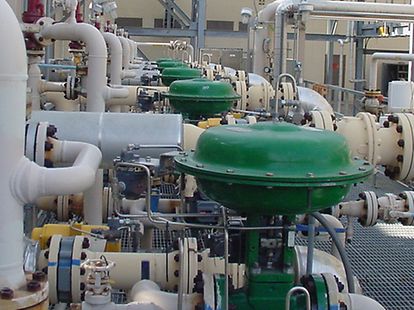Enhancing Operational Effectiveness with Advanced Control Valves
Enhancing Operational Effectiveness with Advanced Control Valves
Blog Article

Maximize Power Financial Savings and Convenience With Advanced Structure Automation Controls
In the realm of modern-day architecture and center monitoring, the assimilation of innovative structure automation controls stands as a critical advancement. By harnessing the power of automation, structures can adapt, react, and evolve in means that were when inconceivable.
Power Efficiency Perks
Energy performance advantages can significantly lower energy usage and operational costs in structures. Energy-efficient systems, such as advanced structure automation controls, can maximize the usage of sources like cooling, home heating, and illumination, leading to reduced energy costs over time.
Additionally, improved energy efficiency can prolong the life expectancy of building tools and systems. By operating much more effectively, heating and cooling systems, light, and other building components experience less wear and tear, causing minimized upkeep and replacement expenses. In addition, energy-efficient buildings commonly regulate higher residential property worths and rental rates, providing lasting monetary advantages to owners.
Additionally, energy efficiency can boost owner comfort and efficiency. Effectively regulated interior settings with ideal lights and thermal problems create an even more favorable and pleasurable office, resulting in improved worker fulfillment and efficiency. Generally, the energy efficiency advantages related to advanced structure automation controls are multifaceted, incorporating cost financial savings, environmental stewardship, and passenger well-being.
Improved Comfort Control
Enhancing convenience control in building atmospheres requires a sophisticated assimilation of innovative automation systems for optimal resident health. By utilizing innovative building automation controls, centers can customize the indoor atmosphere to meet the details needs and choices of owners. These systems make it possible for accurate law of temperature level, lighting, and air flow, creating a effective and comfortable atmosphere. Passenger satisfaction and performance are very closely connected to thermal convenience, making it necessary to have systems in place that can adjust to transforming problems in real-time.
By incorporating these sophisticated controls, buildings can not only boost convenience however also boost power performance by optimizing system procedures based on actual tenancy and usage patterns. Eventually, focusing on passenger comfort with innovative automation systems leads to an extra enjoyable and healthier indoor setting.
Functional Efficiency Improvements

In addition, the implementation of real-time surveillance and analytics devices makes it possible for building drivers to recognize energy ineffectiveness and functional anomalies promptly. By continuously keeping an eye on energy usage patterns and system performance metrics, adjustments can be made in real-time to optimize power intake and make certain peak functional performance. control valves. Furthermore, including need reaction approaches right into building automation controls can further boost functional effectiveness by dynamically readjusting power use based upon grid problems and rates signals
Indoor Climate Optimization
Reliable indoor climate optimization is an essential aspect of building automation controls, making sure passengers' convenience and well-being while maximizing energy savings. By utilizing innovative sensors and controls, developing automation systems can continuously keep track of and readjust temperature, moisture levels, air quality, and air flow to develop an optimum interior setting. Keeping consistent and comfortable problems not just improves passenger complete satisfaction however likewise improves productivity and total wellness.
Interior environment optimization additionally plays a crucial role in power efficiency. By fine-tuning cooling, ventilation, and heating systems based on real-time information and occupancy patterns, constructing automation controls can dramatically decrease energy intake - control valves. For example, implementing techniques such as demand-controlled air flow and thermal zoning can aid lessen energy waste while making sure that each location of the building receives the essential conditioning.

Lasting Setting Creation
Building automation manages not just maximize indoor climate conditions for power effectiveness and owner comfort but also lay the structure for developing a sustainable setting with tactical administration of systems and sources. By integrating innovative structure automation modern technologies, such as sensors, actuators, and intelligent software, centers can check and readjust power usage in real-time to lessen waste and decrease their carbon footprint. These systems make it possible for predictive maintenance, determining potential concerns prior to they rise and enhancing devices performance to boost long life and effectiveness.
In addition, lasting environment production prolongs beyond energy monitoring to encompass water conservation, waste Visit Your URL reduction, and interior air top quality enhancement. Building automation controls can control water usage, find leakages, and ensure proper waste disposal techniques, adding to general sustainability efforts. In addition, by controlling and keeping an eye on ventilation and purification systems, these modern technologies improve resident wellness and performance while reducing power consumption related to cooling and heating procedures.
Final Thought
In verdict, progressed pop over here structure automation controls offer substantial advantages in regards to power savings, convenience control, operational efficiency, interior climate optimization, and creating a sustainable atmosphere. By implementing these controls, buildings can attain ideal efficiency while minimizing power usage and enhancing occupant comfort. It appears that the use of advanced automation innovation is critical in boosting building efficiency and producing a much more lasting future.
Power performance advantages can dramatically lower energy intake and operational prices in structures. On the whole, the power performance benefits associated with advanced structure automation controls are diverse, encompassing cost savings, environmental stewardship, and passenger well-being.
In addition, incorporating need response methods into structure automation controls can further boost functional effectiveness by dynamically readjusting energy usage based on grid conditions and prices signals.
Structure automation regulates not only enhance indoor climate problems for energy efficiency and owner convenience but likewise lay the structure for producing a sustainable environment with critical management of sources and systems.In verdict, progressed structure automation manages deal considerable advantages in terms of energy cost savings, comfort control, functional efficiency, indoor climate optimization, and creating a sustainable setting.
Report this page